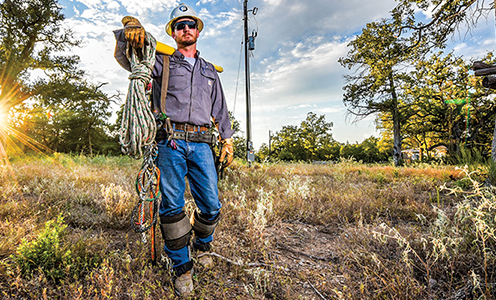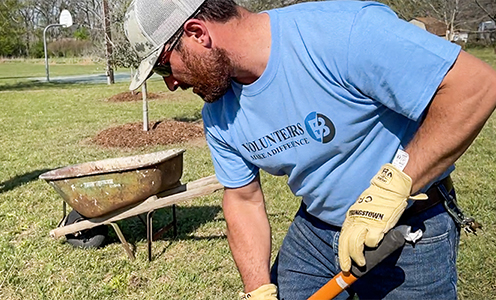Also known as Kovar Hall, it once was among the largest dance halls in Texas — and still draws celebrations
BY CLAYTON STROMBERGER
Back in the day, the SPJST Hall #38 in the Bastrop County community of Kovar, with its huge wooden dance floor and side windows, was the place for a local family to go on a Saturday night — just like SPJST halls all over Central Texas.
After a hard week of working on the farm or in town, Texas Czechs in small rural communities would unwind and celebrate their heritage by dancing to polka music and having a bit of beer as the children skittered around the edges of the dance floor or played chase outside.
SPJST stands for the Slovanska Podporujici Jednota Statu Texas, or Slavic Benevolent Order of the State of Texas. It’s a fraternal organization initially created to provide affordable life insurance for recent immigrants; you would buy insurance, choose a lodge and then be voted in. SPJST was founded in 1897, when a group of Texas Czechs met in La Grange in Fayette County and seceded from a similar 43-year-old national fraternal organization based in Missouri. (The Texans thought the policies and prices were skewed to favor Midwestern Czechs).
The SPJST lodges were numbered as they joined the organization. SPJST Lodge #38 started in 1902 in Smithville, with additional members from nearby Primm (now known as Kirtley) and Kovar, about 10 miles south of Smithville. In 1904, Czechs from Kovar decided they wanted their own lodge, forming SPJST #52. They built a hall in 1910, then a larger one in 1926 – the spacious and sturdy building that stands today, surrounded by pastureland.
It’s down the road from the historic Saints Peter and Paul Mission, built in 1921. In 1944, the Smithville and Kovar lodges combined, and opted to keep the lower and slightly more prestigious number of 38.
Q&A with Donna Zimmerhanzel
We dropped in on the old hall to visit with lodge treasurer, Donna Zimmerhanzel, who rents the non-air-conditioned space out for events when it’s not too cold or oppressively hot. When it was built, Zimmerhanzel says, this was perhaps the largest dance hall in Texas for a time at 72 feet by 100 feet. The lodge has hundreds of official members, but they are scattered around the country. “Their parents bought them insurance when they were babies, then they moved away,” she says. Today there are five active officers: President Alfred Hellinger, vice-president and hall caretaker Edwin Zimmerhanzel (Donna’s husband, whose grandfather helped build the hall), second vice president Johnnie Janak, reporter Dorothy Jean Lastovica, and Edwin and Donna’s daughter Dana “Dee Dee” Bunte. The officers meet monthly at the hall, unless it’s too cold. In that case, they meet in Smithville at Zimmerhanzel’s Bar-B-Que.
What was it like to come here for a dance in the old days?
Back in those days, people didn't sit around and drink and visit. They danced. They came out here to dance. They didn't need tables. When I started dating Edwin in 1958, we used to come out here and dance all the time. We danced in La Grange at the Fair Pavilion and in Smithville at the American Legion. That's what we did for entertainment, mostly on Saturdays. There wasn’t a bar inside in the early days. That little cook shed outside was where you went to get your beer. There were outhouses. The music was usually Czech bands, like Lee Roy Matocha and Joseph Patek.
This was a predominantly Czech community. There were a lot of people that lived here. We had a friend that lived in Smithville, (and) he always said the reason they moved away from here was because in the late 1890s the boll weevil struck. They were raising cotton in this kind of heavy land, and a lot of them moved up to around Taylor, where they could raise cotton. Every May, there’s still a “Kovar Community Reunion” at the hall for people whose ancestors were from the community.
When did electricity come to the hall, and what changes did it bring?
I’d say in the mid-1940s, when the two lodges combined. I think fans were probably the first thing they added – there are still some old box fans in the back, and they might be 50 years old. They ran lines along the beams in the ceiling and put up lights. But they did the bare minimum. They just put one outlet on each side of the hall. When we had the hall rewired in the ’80s, we had to put a big old breaker box on stage for the bands because they kept blowing all the fuses! They also added a fridge and an oven back in the kitchen. I bet both were donated. We bought a more commercial stove and a commercial fridge. Before they added the bathrooms, there was just an outhouse.
Are there still dances here?
We don't do any public dances any more. When we first started taking care of it, our youngest daughter Laura’s husband, Ronnie Frerich, had a family band called the Midnight Owls, and we used to have dances out here all the time. But people just quit going to dances, once they got TVs and phones. I think the last public dance we had here was on New Year's Eve in 1996 because our granddaughter was born that year and we kept her while they played out there that night. The problem (is) you have to have a beer license, you have to have security, and you cannot keep people from passing the beer through the windows. Not when you've got windows like this.
Who uses the hall these days?
We rent it on the weekends through July, mostly for weddings or quinceañeras — we have a lot of those now. Sometimes I come here two or three times a week to show it to people. They'll call me and say, ‘I would like to go look at your venue,’ and I say, ‘Wait a minute, it's just an old barn! It's not a ballroom.’ So many people have said, ‘Why don't y'all air-condition it and heat it?’ Well, that would take away from its ambience. You pick up the key on Thursday, you have all day Friday to decorate, Saturday for your event, you come back on Sunday and clean up. No wonder we rent it! Most of the places want you out by midnight. It's just like my husband said, ‘That's what this hall is for, for people to use.’ That's the only thing we're trying to do, just keep it going.





